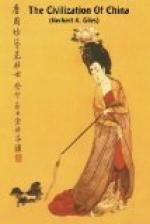In the domain of painting, we are only just beginning to awake to the fact that in this direction the Chinese have reached heights denied to all save artists of supreme power, and that their art was already on a lofty level many centuries before our own great representatives had begun to put brush to canvas. Without going so far back as the famous picture in the British Museum, by an artist of the fourth and fifth centuries A.D., the point may perhaps be emphasized by quotation from the words of a leading art-critic, referring to painters of the tenth and eleventh centuries:—“To the Sung artists and poets, mountains were a passion, as to Wordsworth. The landscape art thus founded, and continued by the Japanese in the fifteenth century, must rank as the greatest school of landscape which the world has seen. It is the imaginative picturing of what is most elemental and most august in Nature—liberating visions of storm or peace among abrupt peaks, plunging torrents, trembling reed-beds—and though having a fantastic side for its weakness, can never have the reproach of pretty tameness and mere fidelity which form too often the only ideal of Western landscape.”
Great Chinese artists unite in dismissing fidelity to outline as of little importance compared with reproduction of the spirit of the object painted. To paint a tree successfully, it is necessary to produce not merely shape and colour but the vitality and “soul” of the original. Until with the last two or three centuries, nature itself was always appealed to as the one source of true inspiration; then came the artist of the studio, since which time Chinese art has languished, while Japanese art, learned at the feet of Chinese artists from the fourteenth century onwards, has come into prominent notice, and is now, with extraordinary versatility, attempting to assimilate the ideals of the West.
The following words were written by a Chinese painter of the fifth century:—
“To gaze upon the clouds of autumn, a soaring exaltation in the soul; to feel the spring breeze stirring wild exultant thoughts;—what is there in the possession of gold and gems to compare with delights like these? And then, to unroll the portfolio and spread the silk, and to transfer to it the glories of flood and fell, the green forest, the blowing winds, the white water of the rushing cascade, as with a turn of the hand a divine influence descends upon the scene. . . . These are the joys of painting.”




